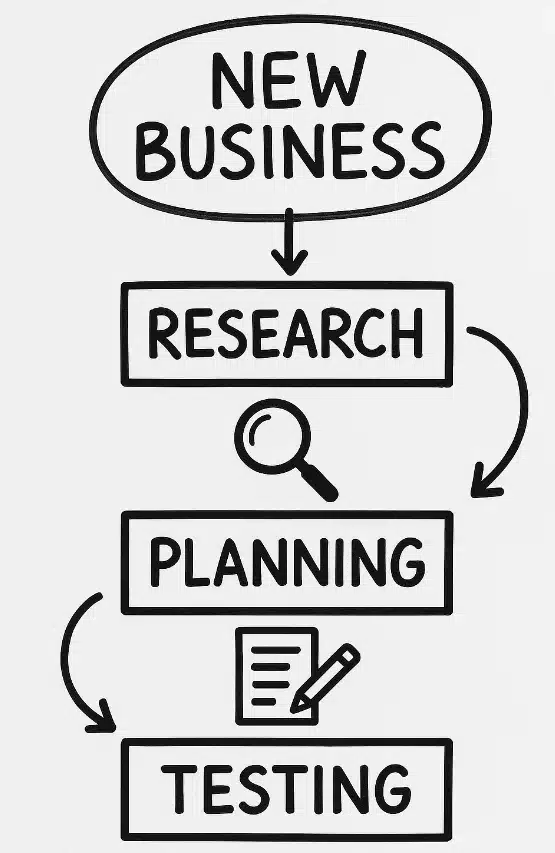How To Conduct The Planning & Research Phase of Your New Business Idea
Updated on September 17, 2025 by Tim Donahue
Starting a business doesn’t begin with branding or launching—it starts with planning and research. If you’re wondering whether your idea is solid, or how to evaluate it properly, this is the stage that can save you months (or years) of wasted time.
In this post, you’ll learn how to do planning and research when starting a business—including how to evaluate your market, test your concept, and build a realistic financial snapshot.
By the end, you’ll know whether your idea is worth pursuing, needs to be adjusted, or should be shelved for now. This isn’t about guessing—it’s about testing your assumptions before you invest real money and time.

Define the Problem and Who You’re Solving It For
Before anything else, you need to be clear: what problem does your business solve, and for who? If you can’t define this in one sentence, pause here. Every great business starts with a specific pain point and a target audience that actually wants it solved.
- What problem are you solving? Is it common, annoying, expensive, or time-consuming?
- Who experiences this problem? Be specific—age, income level, profession, location.
- How are they solving it now? Are they using a workaround, paying a competitor, or just living with it?
Bonus Tip: Use forums, Facebook groups, Reddit, and Amazon reviews to see how real people talk about this problem.
Research Your Market Size and Competition
Once you know the problem and your customer, it’s time to zoom out. Is this market big enough to support your business? And who else is already serving this audience?
- Use free tools like Google Trends, IBISWorld summaries, and Statista for market estimates.
- Search for similar businesses and study their pricing, features, reviews, and marketing.
- Check social media ads and posts—how are they trying to attract attention?
- Identify gaps in what existing businesses offer. Can you do something better, faster, or simpler?
You don’t need to be the first. But you do need a real reason for people to choose you over what already exists.
Create a Simple Financial Forecast
If the idea passes your initial market test, it’s time to look at the numbers. This part doesn’t need to be complicated, but it’s essential. A basic forecast helps you answer one critical question: Can this business make enough money to be worth it?
- Startup costs: What will it take to get up and running? (Think: tools, licenses, product development, website)
- Monthly expenses: What will it cost to operate—marketing, software, hosting, or materials?
- Revenue model: How will you make money? Subscription, one-time sale, service fees, etc.
- Realistic sales projections: Start small—what could you make in your first 3 to 6 months?
- Breakeven point: When would your income start to cover your expenses?
Use a spreadsheet and plug in rough numbers. Your goal isn’t to predict the future perfectly—it’s to see if the model makes sense and has potential to scale.
Pro Tip: If the numbers don’t work out, that’s not failure. It’s information. Adjust pricing, reduce costs, or rethink the scope before going further.
Test Your Idea with Real Users (MVP Prototype)
Before you build a full version of your product or service, you need to test it. That’s where the Minimum Viable Product (MVP) comes in. It’s the quickest, simplest version of your idea that someone can actually use or experience.
- Keep it lean: This isn’t your final product. Use low-cost tools or no-code platforms to create a basic version.
- Put it in front of real people: Ask potential customers to use it. Watch how they interact. Ask questions.
- Track what matters: Are they excited? Confused? Do they come back or refer others?
- Be honest: If no one cares about the MVP, don’t ignore that. Adjust and try again—or rethink the concept.
This testing phase can save you thousands of dollars and months of effort. If people love the prototype, that’s a great sign you’re onto something.
Evaluate the Results Honestly
After you’ve gathered research, tested your MVP, and built a basic forecast, it’s time for the hardest part: deciding what to do next.
- Did people care about the problem and your solution?
- Did users find your MVP useful or exciting?
- Do the numbers suggest you could turn a profit within a reasonable time?
- What surprised you most—and how does that affect your strategy?
- Are there risks you didn’t see before? Can you manage them?
Be brutally honest. Sunk cost thinking—sticking with something just because you’ve already put time into it—can kill a startup faster than anything.
Outline a Rough Marketing Strategy
If you’re feeling confident about the idea, it’s time to sketch how you’ll reach your first customers. Even the best product will flop if no one hears about it.
- Where does your audience hang out online or in person?
- What channels can you use to reach them? (e.g. email, social, SEO, paid ads)
- What kind of message will grab their attention fast?
- Can you offer something valuable upfront? (free trial, sample, consultation)
For help with online promotion, check out our post on how to use social media for your business.
The goal here is simple: figure out how you’re going to get your first 10–50 customers.
Can You Afford to Launch?
One last filter: do you have (or can you realistically get) the resources to move forward? That includes both money and time.
- How much cash do you need to launch and operate for 6–12 months?
- Can you self-fund, or will you need help? (loans, investors, crowdfunding)
- How much time can you commit weekly—especially if you’re working another job?
- What sacrifices are you prepared to make?
If the answer is “I can’t do this right now,” that’s okay. You can always revisit the idea when things change—or tweak it to fit your current reality.
Check out this post on bootstrapping if you want to launch with minimal outside funding.
Make the Call: Go, Pivot, or Park It
After all this research, planning, and testing, you’re ready to make a call. There’s no perfect formula, but here’s a rough guide:
- Go forward if the feedback is positive, numbers make sense, and you’ve got the resources.
- Pivot if the response was “meh” but you see ways to improve the offer or audience.
- Park it if no one cared, the numbers don’t work, or the timing just isn’t right.
This decision doesn’t lock you in forever. You’re building something real—not chasing a fantasy. And that means making clear, informed decisions at every step.
The Planning & Research Phase isn’t about perfection—it’s about proof.
Use this phase to test your assumptions, gather honest feedback, and figure out if your idea deserves your full attention and effort.
Next Steps
If you’re ready to move forward, your next move is to start putting together a detailed plan and early operations roadmap. A few helpful reads from our site:
